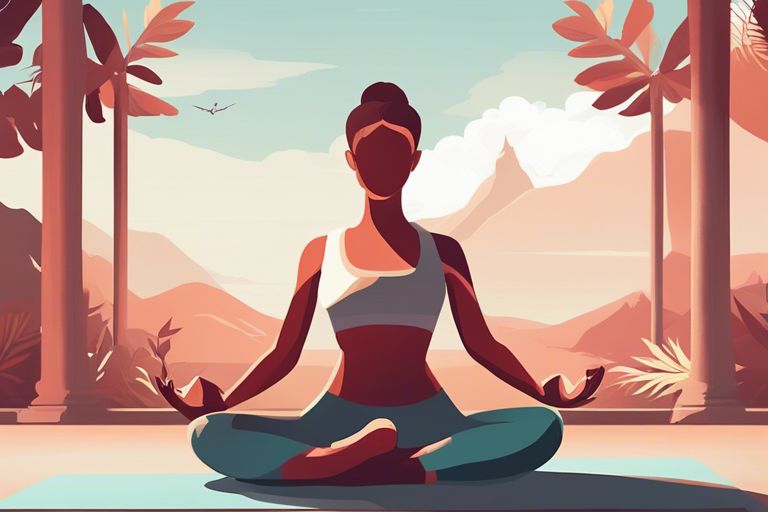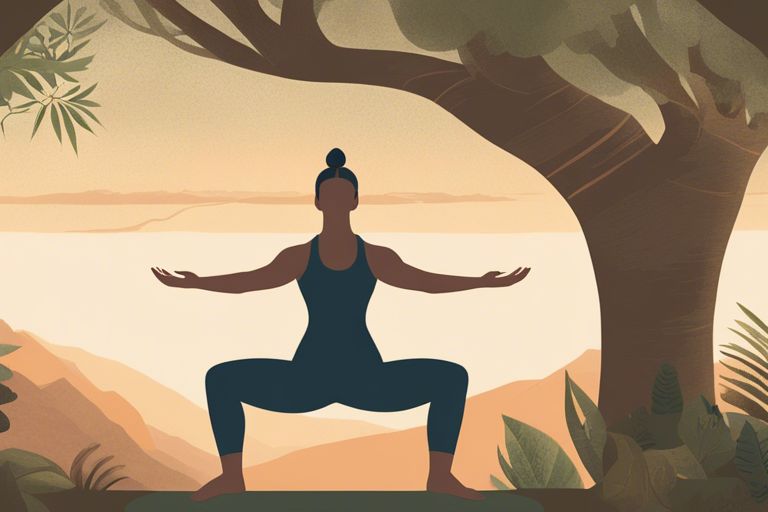Just getting started with yoga or looking to enhance your practice? This dynamic yoga poses routine will help you build strength and improve flexibility in your body. From energizing sun salutations to empowering warrior poses, each posture is carefully selected to target different muscle groups and enhance your overall practice. So roll out your mat, breathe deeply, and let’s flow through this invigorating sequence together!
Key Takeaways:
- Variety: Incorporating a dynamic routine of yoga poses helps in engaging different muscle groups and enhancing overall strength and flexibility.
- Breath Control: Focusing on proper breathing techniques while transitioning between poses can improve stamina and relaxation during the practice.
- Progressive Challenge: Gradually increasing the difficulty of poses in the routine allows for continuous growth in both physical and mental aspects of yoga practice.
1. Warm up with gentle stretches for 5-10 minutes.
2. Start with dynamic poses like sun salutations for flow.
3. Focus on holding challenging poses for strength building.
4. Incorporate balance poses for stability and concentration.
5. Include hip opening poses for increased flexibility.
6. Finish with a cool down and relaxation for recovery.

Understanding the Benefits of Dynamic Yoga
A dynamic yoga practice focuses on fluid movements and transitions between poses, providing a cardiovascular workout while also building strength and flexibility. By incorporating dynamic yoga into your routine, you can improve your overall physical fitness, enhance your endurance, and increase your mind-body connection.
Types of Dynamic Yoga
There are several types of dynamic yoga practices that you can explore, each offering unique benefits. Some popular forms include Vinyasa, Power, and Ashtanga yoga. These styles involve continuous movement synced with breath, helping you to build heat in the body and increase your heart rate. Incorporating dynamic yoga into your fitness regimen can help you achieve a balanced workout that targets both strength and flexibility. Any regular practice can lead to improved muscle tone, enhanced flexibility, and increased energy levels.
| Vinyasa Yoga | Power Yoga |
| Ashtanga Yoga | Bikram Yoga |
| Kundalini Yoga | Jivamukti Yoga |
Factors to Consider for Optimal Results
Clearly, there are a few key factors to keep in mind to make the most of your dynamic yoga practice. Firstly, focusing on proper breath control, alignment, and mindfulness during each session can help you prevent injuries and deepen your practice. Additionally, listening to your body and honoring its limits is crucial in avoiding overexertion and promoting long-term progress. Any modifications or variations can be made to suit your individual needs and goals.
Yoga is a powerful tool for enhancing both physical and mental well-being. By incorporating dynamic yoga into your fitness routine, you can experience a wide range of benefits, including improved strength, flexibility, and overall vitality. Remember to approach your practice with awareness and a willingness to adapt, allowing you to progress at your own pace while reaping the rewards of a dynamic yoga practice.

Preparing for Your Dynamic Yoga Routine
There’s no denying the numerous benefits of a dynamic yoga routine for improving strength and flexibility. Before you jump into your practice, it’s important to adequately prepare your body and mind for the challenges ahead.
Essential Tips for Beginners
- Start Slow: Begin with basic poses and gradually progress to more challenging ones as you gain confidence and strength.
- Focus on Alignment: Proper alignment is crucial to prevent injuries and maximize the benefits of each pose.
- Listen to Your Body: Pay attention to how your body feels during each pose and adjust accordingly to avoid pushing yourself too far.
Knowing your limits and respecting your body’s capabilities is key to building a strong foundation for your dynamic yoga practice.
Creating a Conducive Environment
The environment in which you practice yoga can greatly affect the quality of your routine. Creating a space that is quiet, clutter-free, and comfortable can help you focus better and minimize distractions.
Conducive environments can also include good lighting, proper ventilation, and inspiring decor to enhance your overall experience and make your yoga practice more enjoyable.
Step-by-Step Guide to Dynamic Yoga Poses
Despite the many benefits of yoga for strength and flexibility, it can be challenging to know where to start when incorporating dynamic poses into your routine. To help you on your journey, check out this Yoga Sequence That Builds Both Strength and Flexibility.
Foundational Poses for Strength and Flexibility
For a solid foundation in your yoga practice, it’s vital to start with poses that focus on building both strength and flexibility. Some of the foundational poses you can incorporate into your routine include Downward-Facing Dog, Warrior I, and Plank Pose. These poses help to strengthen your core, legs, and arms while also increasing flexibility in your hips, shoulders, and spine.
Intermediate Poses for Balance and Coordination
There’s a point in your practice where you begin to advance to more intermediate poses that challenge your balance and coordination. Poses like Tree Pose, Crow Pose, and Revolved Triangle Pose require you to engage multiple muscle groups simultaneously for stability and control.
For instance, advancing to poses that require you to balance on one leg or support your body weight with your arms not only enhances your physical strength but also improves your mental focus and concentration.
Advanced Poses for Enhanced Flexibility and Strength
| If you have mastered intermediate poses and are looking to take your practice to the next level, incorporate advanced poses into your routine for enhanced flexibility and strength. | Benefits |
| King Pigeon Pose | Improves hip flexibility and backbends |
| Scorpion Pose | Strengthens the core and shoulders |
| Handstand | Boosts upper body strength and balance |
Strength, control, and flexibility are vital components of an advanced yoga practice. These poses not only challenge your physical capabilities but also encourage mindfulness and body awareness. Remember to listen to your body and progress at your own pace to avoid injuries and enjoy the journey of self-discovery through yoga.

Tips for Modifying and Customizing Your Routine
Many times, you may find that a standard yoga routine doesn’t quite fit your needs or abilities. That’s okay! Yoga is a highly adaptable practice, and there are plenty of ways to modify and customize your routine to suit your body and goals. Here are some tips to help you make your practice work for you:
- Listen to your body: Pay attention to how each pose feels and make adjustments as needed to prevent injury.
- Use props: Blocks, straps, and bolsters can help you get into proper alignment and make poses more accessible.
- Focus on breath: Your breath is a powerful tool in yoga. Remember to breathe deeply and stay present in each movement.
- Experiment with different sequences: Don’t be afraid to switch up the order of poses or try out new flows to keep your practice fresh and exciting.
- Consult with a teacher: If you’re unsure how to modify a pose or sequence, don’t hesitate to ask a knowledgeable instructor for guidance.
Accommodating Different Body Types and Needs
Many bodies have different abilities and limitations, so it’s important to make your practice inclusive and adaptable to suit a variety of needs. You can modify yoga poses in several ways to accommodate different body types and abilities. Any routine can be adjusted to make it more accessible and enjoyable for you.
| Accommodating | Incorporating |
| Use of props | Try different props and accessories |
| Focus on alignment | Adjust poses to fit your body |
| Modify intensity | Experiment with different variations |
| Go at your own pace | Customize the flow to suit your needs |
| Listen to your body | Engage with your body’s feedback |
Incorporating Props and Accessories
Your practice can benefit greatly from using props and accessories to support and enhance your poses. Blocks, straps, blankets, and bolsters can assist you in achieving proper alignment, deepening stretches, and creating stability in challenging poses. Body props can also help prevent injury and make the practice more accessible for beginners or those with physical limitations. Don’t hesitate to experiment with different props to see how they can enhance your practice.
Factors to Consider for a Safe and Effective Practice
Keep these factors in mind when practicing yoga poses to ensure a safe and effective routine:
- Remember to focus on your breath throughout the practice.
- Warm up properly before exploring into more advanced poses.
- Listen to your body and modify poses as needed to prevent injury.
- Stay hydrated and fuel your body with nourishing foods before and after your practice.
Though yoga is a wonderful way to build strength and flexibility, it’s crucial to approach your practice mindfully and with care.
Common Mistakes to Avoid
With any physical practice, there are common mistakes that can hinder your progress and potentially lead to injury. Some of these include:
- Pushing yourself too hard and forcing your body into poses beyond its current capabilities.
- Not paying attention to your alignment, which can strain muscles and joints.
Preventing Injuries and Strains
Effective ways to prevent injuries and strains in yoga include:
A proper warm-up can help prepare your muscles and joints for the poses ahead. Additionally, paying attention to your form and alignment can help reduce the risk of overstretching or straining. Bear in mind, yoga is a practice of self-awareness and acceptance; honor your body and its limits to progress safely and effectively.
Weighing the Pros and Cons of Dynamic Yoga
Once again, when considering incorporating dynamic yoga into your routine for strength and flexibility, it is important to weigh the pros and cons to make an informed decision. Below, you will find a breakdown of the advantages and potential drawbacks of dynamic yoga.
| Pros of Dynamic Yoga | Cons of Dynamic Yoga |
|---|---|
| Best Yoga Poses for Flexibility & Mobility | Less emphasis on mindfulness |
| Increases strength and endurance | Higher risk of injury due to fast-paced movements |
| Improves cardiovascular health | May not be suitable for beginners |
| Enhances overall body coordination | Less focus on relaxation and stress relief |
Advantages of Dynamic Yoga for Strength and Flexibility
Flexibility: Dynamic yoga can help improve your flexibility by moving through various poses that stretch and lengthen your muscles. This can contribute to increased range of motion and better mobility in your joints. Additionally, dynamic yoga sequences often incorporate continuous movement, which can help build heat in the body and further enhance your flexibility.
Potential Drawbacks and Limitations
Potential Drawbacks and Limitations
Dynamic: One potential drawback of dynamic yoga is the increased risk of injury due to the rapid transitions between poses and the faster pace of the practice. It is important to listen to your body, practice proper form, and not push yourself beyond your limits to avoid potential strains or injuries.
With a clear understanding of the pros and cons of dynamic yoga, you can make an informed decision about whether incorporating this practice into your routine aligns with your fitness goals and preferences. Remember to always prioritize safety and listen to your body to maximize the benefits of your yoga practice.
Considering all points
As you continue to practice this dynamic how-to yoga poses routine for strength and flexibility, you will notice significant improvements in your overall physical well-being. By incorporating a variety of poses that target different muscle groups, you are not only enhancing your strength but also increasing your flexibility. The balance between strength and flexibility is imperative for preventing injuries and improving your performance in various physical activities.
Remember to listen to your body and adjust the poses as needed to suit your own abilities and limitations. Consistency is key when it comes to reaping the benefits of yoga, so make sure to practice regularly and challenge yourself to go further each time. Embrace the journey of self-improvement and enjoy the transformation that comes with dedicating yourself to this dynamic yoga routine.
FAQ
Q: What is a dynamic yoga routine?
A: A dynamic yoga routine involves flowing sequences of poses that are synchronized with the breath, allowing for a continuous movement that helps build strength and flexibility.
Q: How can yoga poses help improve strength?
A: Yoga poses require engaging various muscle groups, which helps strengthen them over time. By holding poses and transitioning between them, you can enhance muscle endurance and overall strength.
Q: Is flexibility the only benefit of practicing yoga poses?
A: No, along with increased flexibility, practicing yoga poses can also improve balance, posture, concentration, and reduce stress. It offers a holistic approach to fitness and well-being.











